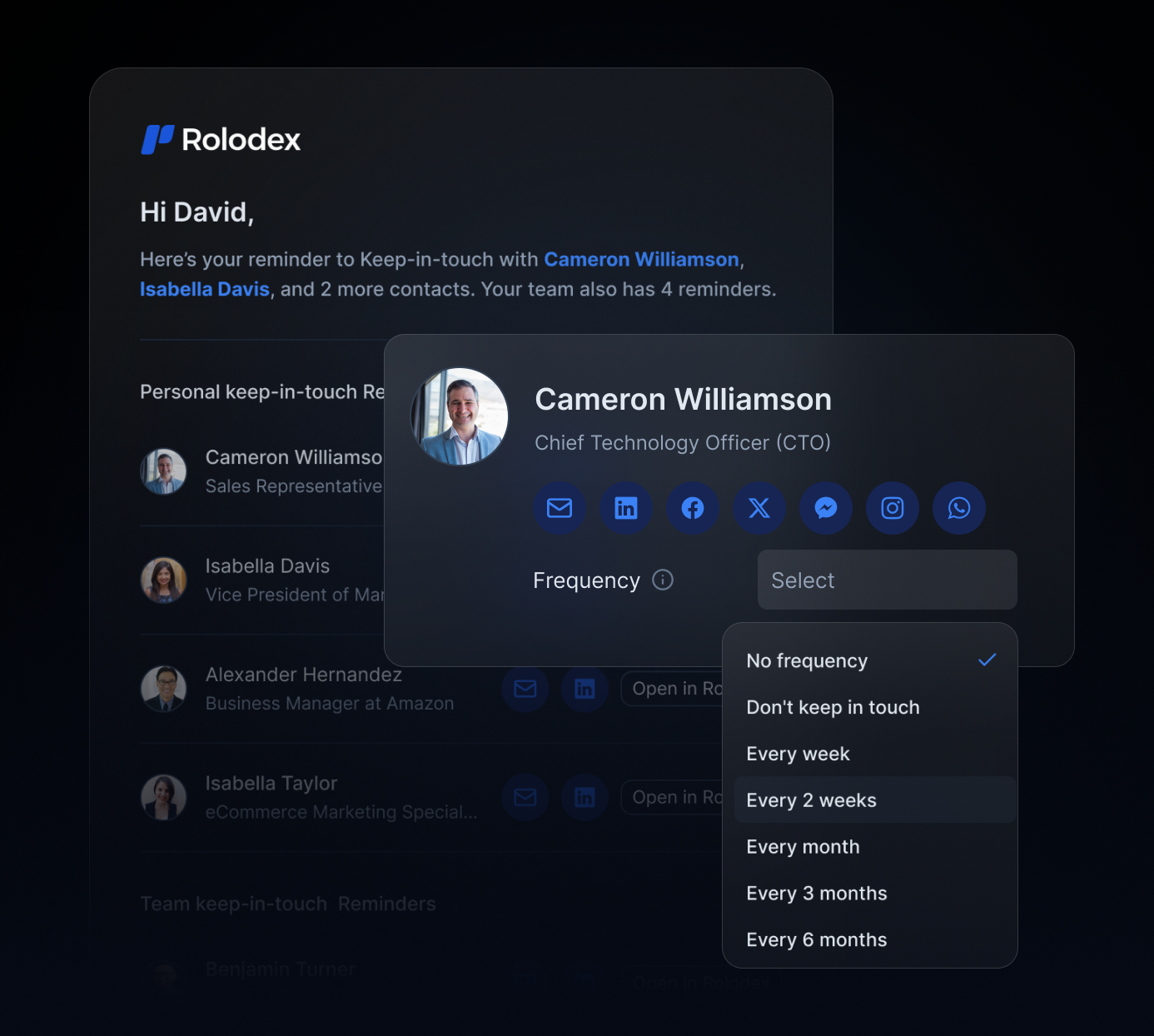Most busy operators have the same experience: you’re great in the moment, but quarter after quarter a handful of important relationships slip—someone gets promoted and you miss it, a warm ally goes quiet, a promise to “circle back next month” turns into radio silence. It isn’t negligence. It’s math.
What Dunbar’s number actually says (and why it still matters)
Anthropologist Robin Dunbar linked primate neocortex size to typical group size and—when extrapolated to humans—found we can sustain about 150 stable relationships at once. It’s not a hard cap, but a practical band created by cognitive limits and the time it takes to maintain ties. Research also finds relationships form layers (~5 intimate, ~15 close, ~50 good, ~150 meaningful), a pattern that shows up in historical groups and modern life. Digital tools help us find more people, but they don’t remove the maintenance cost of keeping them warm.
Large-scale, modern datasets echo the same range. Studies of Twitter conversations show people maintain a relatively constant number of active ties (~100–200) even on high-velocity platforms; activity spreads across many contacts, but stable, reciprocal relationships concentrate within that band.
There’s healthy debate on the precision of “150.” A 2021 critique argues for variability by individual and context; Dunbar’s recent review replies that layered limits remain a robust empirical pattern. The useful takeaway: treat 150 as a design constraint, not a fixed wall—but accept that attention and time are the real bottlenecks.
The operator’s problem: breadth vs. depth
Sales, partnerships, fundraising, and recruiting routinely require far more than 150 active relationships—champions, prospects, referrers, candidates, advisors, alumni. Manually juggling that many ties forces a tradeoff: either you spread yourself thin and go generic, or you go deep with a few and let the rest cool. Dunbar’s work explains why the juggling fails; your calendar confirms it.
Systems beat hustle: how Rolodex extends your memory
You don’t need a bigger brain—you need a memory extension that handles timing and context so your limited attention lands where it matters.
Title Alerts: never miss the moment
Role and company changes are the best re-engagement triggers. Title Alerts surface promotions and job moves automatically so you can respond with a timely, specific congrats instead of a generic check-in. In practice, this refreshes ties before they fall out of your ~150 “active” circle. Recent coverage of Dunbar’s number underscores how recency and frequency keep relationships in closer layers; Title Alerts give you those moments on a platter.

Keep-in-Touch: scheduled nudges that prevent quiet decay
Set light cadences by segment—quarterly for champions and partners, twice-yearly for friendly investors, annually for alumni and advisors. Gentle, scheduled nudges keep acquaintances from sliding into the void without turning your week into admin.

Activity Feed + Notes & Attachments: context at a glance
After each call or coffee, log a one-screen note (situation, decisions, next steps) and attach the deck or transcript. Next time you look someone up, the Activity Feed shows the whole story in order. This preserves the social memory Dunbar’s layers imply you’d otherwise lose as your network grows.

Boards View for warm paths (optional but powerful)
When a teammate can open a door, track that introduction like a mini-funnel—Requested → Intro Sent → Meeting → Outcome—with clear owners and quick SLAs. Shared visibility spreads upkeep across the team, letting a small org collectively maintain thousands of relationships without any single person carrying them all.

A weekly “Beyond 150” ritual (30 minutes, compounding)
5 minutes — Signals. Open Title Alerts and send two specific congrats messages. These moments keep you in closer layers.
10 minutes — Cadence. Clear your Keep-in-Touch queue. Skim the Activity Feed and send a relevant one-liner with a light next step.
10 minutes — Intros. Advance any warm-intro cards (reply within 1 business day, propose times within 24 hours, thank the introducer within 24 hours post-meeting).
5 minutes — Memory. Pin a “Current Truth” note on one strategic contact so anyone on the team can step in cold.
Run this loop for a quarter and you’ll feel it: more timely replies, fewer “missed their promotion” moments, and a broader ring of warm relationships—with the same number of hours in your week.
The takeaway
Dunbar’s number explains why relationships quietly cool even when your intentions are good: attention and time don’t scale. You won’t beat that ceiling with more late-night inbox sessions. You’ll beat it with systems that remember for you, nudge you at the right time, and let your team share the work.
That’s what Rolodex is built to do—Title Alerts so you never miss the moment, scheduled nudges so ties don’t decay, and an Activity Feed that keeps every touchpoint alive in one place. Go beyond 150—without burning out.
Sources & further reading
Dunbar, R. I. M. (1992). Neocortex size as a constraint on group size in primates. Journal of Human Evolution. Foundational analysis behind the “~150” estimate. ScienceDirect
Konnikova, M. (2014). The Limits of Friendship. The New Yorker. Accessible explainer on Dunbar’s layers and why digital tools don’t remove maintenance costs. The New Yorker
Gonçalves, B., Perra, N., Vespignani, A. (2011). Validation of Dunbar’s Number in Twitter conversations. PLOS ONE. Large-scale evidence for ~100–200 active ties online. PLOS+1
Lindenfors, P. (2021). ‘Dunbar’s number’ deconstructed. Biology Letters. Statistical critique emphasizing variability. PMC
Dunbar, R. (2024). The social brain hypothesis—thirty years on. Annals of Human Biology. Recent review reaffirming layered networks and typical human group sizes. Tandfonline
Wall Street Journal (2025). Our Brains Evolved to Socialize—but Max Out at About 150 Friends. Current overview of Dunbar’s number in modern life. Wall Street Journal
